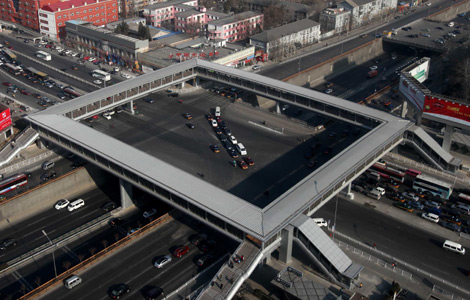Beating Beijing's bus blues
Updated: 2012-01-04 17:05
By Brian Salter (chinadaily.com.cn)
|
|||||||||||
When travelling around Beijing, the subway system is excellent for getting from A to B, although I have to say that it is hardly the most comfortable way to travel and rarely do I ever get a seat. Given a preference, I will always choose the buses, albeit that they too can be extremely crowded at times.
Taking the bus, you can get a real feel for the city – something that is impossible in the dark tunnels underground. You can see things you might never have seen, get a better feel for the city and its layout; and despite the ever growing subway network, there are places that are still unreachable by train.
But it is not easy for foreigners who cannot read Chinese. The bus stops themselves remain a total mystery to me, with only the end destination and the name of the bus stop written in Pinyin. And plotting a route across the city is a time-consuming job using the internet.
True, there's a web site (http://www.beijingchina.net.cn/transportation/bus.html) that has an interactive map on it into which you can search for bus stop names, bus numbers and other criteria, but for some weeks now only the Chinese version has been working, not the English option, so I find myself back at square one, though it is useful for playing what-if games by entering bus numbers at random and seeing where on the map they go.
What I have also done is to make myself a pocket list of which buses serve all the city's subway stations. (This was made easy by a really useful site - http://www.travelchinaguide.com/cityguides/beijing/transportation/ - which as well as listing bus numbers, also gives information on which exits to take for particular places to visit.)
When I need to go somewhere new, and have no idea which bus to take, I search for the nearest subway station, look up which buses go there, and then one by one enter those bus numbers into the interactive map to see if they go anywhere near my intended destination. When I have found one that does, I then copy the name of the bus stop in Chinese from the interactive map, paste it into a new search in the Chinese version of the map, using the non-working English version as a guide of which search field to enter, and try my luck to see what other buses go there and if any of them start from where I want to start from!
Every time I go somewhere new that I might wish to go to again, I make a note of all the bus numbers at that particular spot and add it to my little book. Later I can see which subway stations those buses run past using a quick search of my Word document archive.
I have to say that I am getting expert in this very roundabout way of finding how to use the Beijing bus network, and have already got myself a reputation for being able to advise others on which bus routes to take.
But as China gets ever more popular as a destination for foreigner visitors, I hope it won't be too long before the transport authorities set themselves the task of simplifying the system to make it a bit easier for their foreign guests to get around.
The author is a broadcaster and journalist who spent 10 years working in Saudi Arabia and Dubai before moving to Beijing in 2011.
- Measures to boost buying amid export decline
- China protests islands visit by Japan
- China to play greater role in 2012
- China axes TV entertainment shows
- New Year's art starts controversy
- Taliban to set up office in Qatar
- Man used fake Wendi Deng Twitter
- CPI to ease further this year despite inflation
Hot Topics
Kim Jong-il, Mengniu, train crash probe, Vaclav Havel, New Year, coast guard death, Internet security, Mekong River, Strait of Hormuz, economic work conference
Editor's Picks

|

|

|

|

|

|






